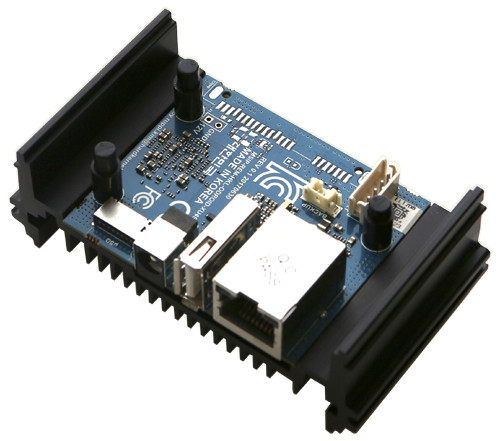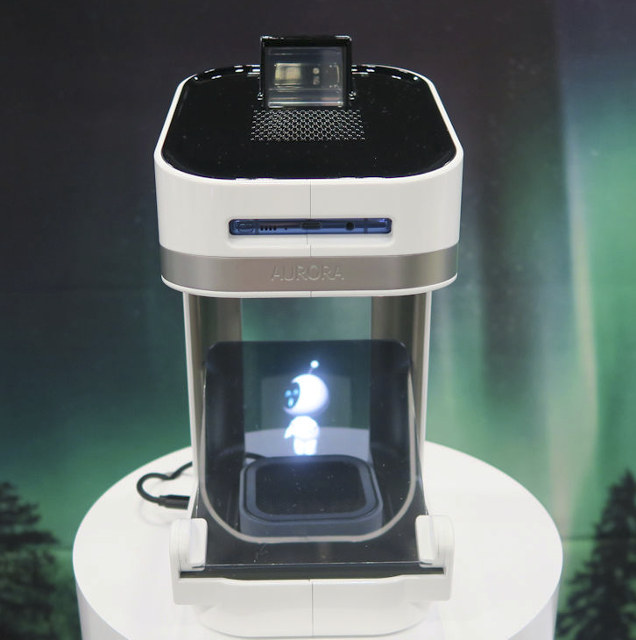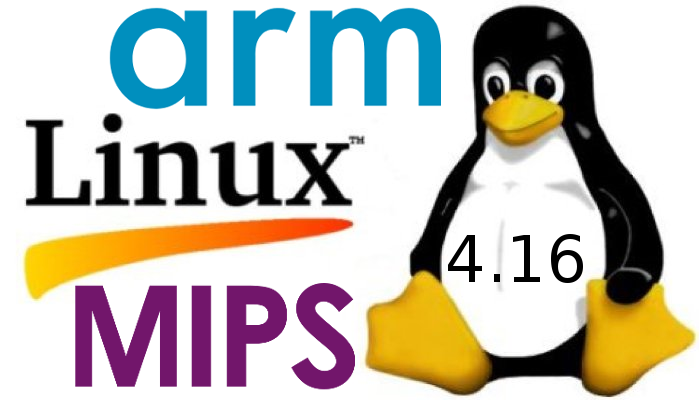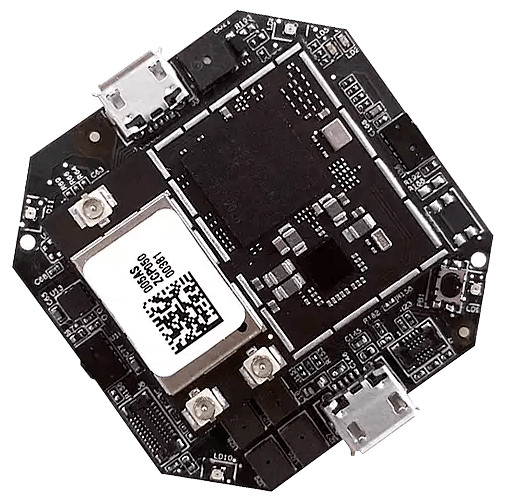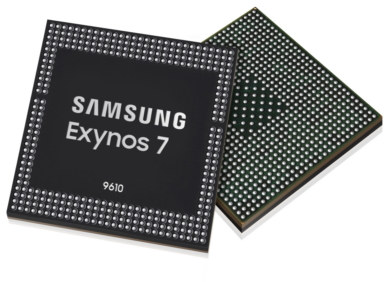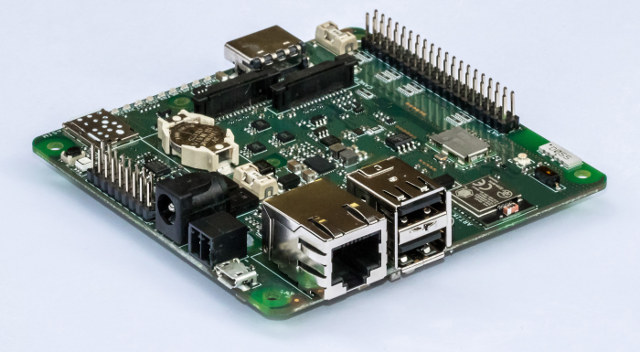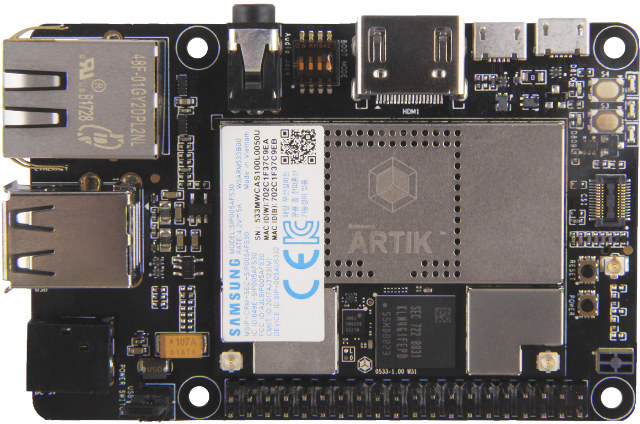Hardkernel launched ODROID-MC1 (My Cluster One) at the end of last year with four ODROID-XU4S boards powered by Samsung Exynos 5422 processor with Gigabit Ethernet, metal cases, and a cooling fan. As the name implies it is designed for cluster of boards, but the company found out that one size (4 boards) does not fit all, so they are now offered ODROID-MC1 Solo with one ODROID-XU4S board and stackable case to provide more flexibility to their customers. Here’s a reminder of the specifications: SoC – Samsung Exynos 5422 quad core ARM Cortex-A15 @ 2.0GHz quad core ARM Cortex-A7 @ 1.4GHz with Mali-T628 MP6 GPU supporting OpenGL ES 3.0 / 2.0 / 1.1 and OpenCL 1.1 Full profile System Memory – 2GB LPDDR3 RAM PoP Storage – 1x micro SD slot (UHS-1 capable) Network Connectivity – 10/100/1000Mbps Ethernet (via Realtek RTL8153 USB 3.0 to Ethernet bridge) USB – 1x USB 2.0 […]
Samsung Aurora Smart Speaker Prototype is Powered by a Smartphone, Features an Hologram-like Character
Samsung Electronics has showcased a smart / A.I. speaker prototype at SXSW 2018 trade show last month, that can be manufactured at low cost since it relies on a smartphone to provide a processor, microphone, and other equipment. The smart speaker also uses the smartphone’s screen to show an hologram to greet users. Meet Samsung “Aurora”. The smartphone is placed horizontally (blue above) in a slot in the upper part of the speaker, and a hologram-like character floats above the Bluetooth speaker included of the kit. The part on the top surface is an optical mechanism using the smartphone’s camera for image recognition. The smart speaker also charges the phone, but it’s unclear how you are supposed to answer phone calls once it is inserted in the speaker… The concept looks similar to Vinclu Gatebox which we covered in 2016, except it relies on a smartphone. Samsung is said to […]
Linux 4.16 Release – Main Changes, Arm and MIPS Architectures
Linus Torvalds has just released Linux 4.16: So the take from final week of the 4.16 release looks a lot like rc7, in that about half of it is networking. If it wasn’t for that, it would all be very small and calm. We had a number of fixes and cleanups elsewhere, but none of it made me go “uhhuh, better let this soak for another week”. And davem didn’t think the networking was a reason to delay the release, so I’m not. End result: 4.16 is out, and the merge window for 4.17 is open and I’ll start doing pull requests tomorrow. Outside of networking, most of the last week was various arch fixlets (powerpc, arm, x86, arm64), some driver fixes (mainly scsi and rdma) and misc other noise (documentation, vm, perf). The appended shortlog gives an overview of the details (again, this is only the small stuff in […]
RushUp KITRA Board Family is based on Samsung Artik 020, Artik 520/530, or Artik 710 Modules
Samsung first announced their Artik IoT modules almost three years ago, and until recently most Artik related products or development kits came from Samsung themselves, with no third party involved. But this has started to change recently with announcements such a Seeed Studio Eagleye 530s low cost development board based on Artik 530 module, and Resin.io Project Fin combining RPI CM3L module with an Artik 020 module for low power Bluetooth connectivity. But as I flicked through Resin.io supported hardware, I discovered they also supported Linux powered Artik 520 and Artik1020 module, as well as some new “KITRA” boards I had never heard of, and if we visit RushUp company website, we can see they have a bunch of Kutra boards and one IoT gateway based on Artik modules: KITRA 520 – Samsung ARTIK 520 product accelerator for advanced IoT KITRA 710 – Samsung ARTIK 710 product accelerator for advanced multimedia […]
Samsung Exynos 9610 (7 Series) Processor Unveiled with Full HD 480 FPS Slow-Motion Support
Samsung has announced yet another Exynos 7 series application processor with Exynos 9610, built on Samsung’s 10-nanometer (nm) FinFET process, and supporting premium features such as deep learning-based image processing and slow motion video recording at 480 frames per second in full HD. The SoC includes four Cortex-A73 cores, four Cortex-A53, and Arm Mali-G72MP GPU, a sensor hub based on a Cortex M4F real-time core, an LTE Cat 13 modem, 802.11ac WiFi and more. Samsung Exynos 9610 key specifications: CPU – Quad core Arm Cortex-A73 @ up to 2.3 GHz, quad core Arm Cortex-A53 @ up to 1.6 GHz GPU – Arm Mali-G72 MP3 Memory I/F – LPDDR4x Storage I/F – UFS 2.1, eMMC 5.1 Display – Up to WQXGA (2560×1600) Camera – Rear: 24MP; Front: 24MP,; Dual Camera: 16+16MP Video – 4K UHD 120fps encoding and decoding with HEVC/H.265), H.264, VP9 Connectivity LTE Modem – LTE Cat.12 3CA 600Mbps […]
BalenaFin is an Industrial Carrier Board for Raspberry Pi CM3L Module Designed for Fleets of Connected Devices
[Update January 2019: Resin.io Project Fin has been renamed to BalenaFin, I have not changed the rest of the article] Resin.io is a both a company and a software platform that includes device, server, and client software to get code securely deployed to a fleet of devices. Devices are setup to run ResinOS, and to deploy you app, you just need to push the code to resin.io build servers, where it will be packaged into containers and delivered to your fleet of boards. So far, resin.io relied on existing hardware platforms like Raspberry Pi 3, BeagleBone Black, or Intel NUCs, but they’ve now decided to launch their first hardware with Project Fin that takes a Raspberry Pi Compute Module 3 Lite, is hardened for field deployment use cases, and adds some of most commonly requested hardware features such as variable supply voltage support, RTC, and cellular connectivity (via mPCIe card). […]
Eagleye 530s Board Features Samsung Artik 530s IoT Module, Leverages Raspberry Pi Form Factor
Samsung Artik 530 is a module designed for the Internet of Things based on a quad core Arm Cortex A9 processor, and supporting Ethernet, dual band WiFi, Bluetooth 4.2, and 802.15.4/Zigbee/Thread connectivity, as well as exposing display and camera interfaces, and of course various I/Os. The module was launched about one year ago with a developer kit that cost $189 and up, but Samsung has now worked with Seeed Studio to launch a cheaper developer board – called Eagleye – based on the secure version of the module (Artik 530s) and mostly following Raspberry Pi form factor in order to take advantage of its hardware ecosystem. Eagleye 530s board specifications: SoC – Unnamed quad core Arm Cortex A9 processor @ 1.2GHz with 3D graphics accelerator System Memory – 1GB DDR3 Storage – 4GB eMMC flash, SD card slot Connectivity 802.11a/b/g/n dual band SISO (2.4G/5G) Bluetooth 4.2(BLE+Classic) Zigbee/Thread 802.15.4 Gigabit Ethernet […]
Samsung Galaxy S9 and S9+ Smartphones Launched with Snapdragon 845 or Exynos 9810 SoC
After various leaks on the web, Samsung has now officially launched their flagship smartphones – Samsung Galaxy S9/S9+ – at Mobile World Congress 2018. The phones look very much like last year’s Samsung S8/S8+ smartphones, but include faster processors with either Qualcomm Snapdragon 845 or Samsung Exynos 9810, better cameras (e.g. super slow motion mode @ 960 fps, low light improvements), some design tweaks (fingerprint scanner under the camera instead of on the side), and some new software features, like AR Emoji that creates your own virtual avatar based on your photo. Samsung Galaxy S9/S9+ specifications: SoC Qualcomm Snapdragon 845 octa-core processor with four Kryo 385 cores @ up to 2.8 GHz, four Kryo 385 cores @ up to 1.7 GHz, Adreno 630 GPU; 10nm Samsung Exynos 9810 oct-acore processor with four Exynos M3 core @ up to 2.7 GHz (Anandtech claims the max frequency can only be achieved when […]


